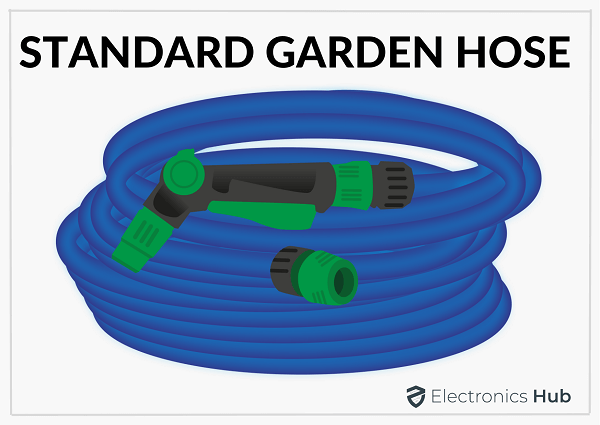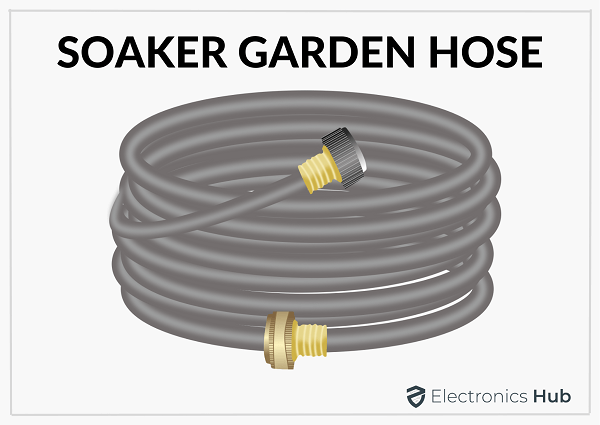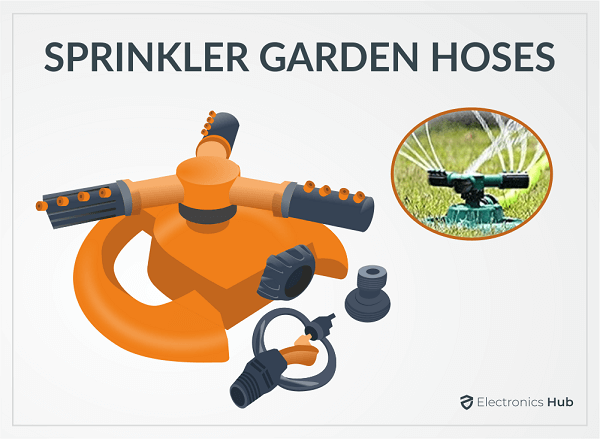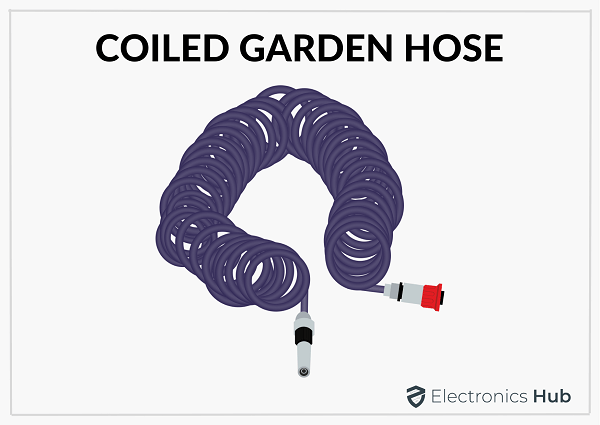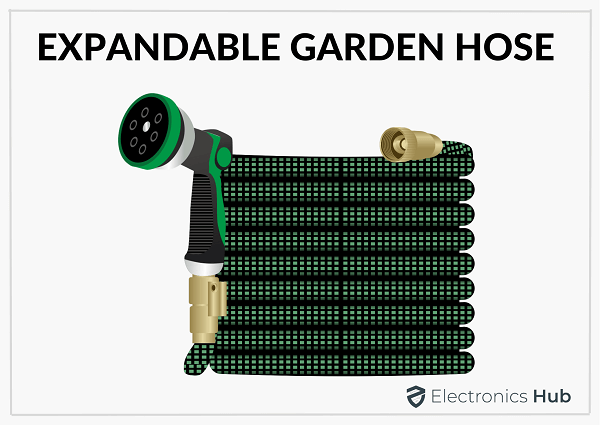A garden hose is an important piece of equipment for homeowners who have yards or lawns. They make the watering process much easier and convenient.
However, not every garden hose is designed equal. Although, there are several factors to differentiate them. Among them, we are going to explore the aspect of different garden hose types.
If you are in the market to purchase a new garden hose, then the information mentioned in this article helps to choose the right option for your requirements.
Make sure to read the information thoroughly to understand the variations and make the wise decision.
Outline
ToggleDifferent Types of Garden Hoses
Here are the different models of garden hoses available
- Standard
- Soaker
- Sprinkler
- Flat
- Coiled
- Expandable
- RV/Marine
- Drinking Water Safe
1. Standard Garden Hose
These hoses are made from vinyl, sometimes with multiple layers or reinforcing mesh. Since moulded vinyl or rubber is used to make these hoses, it is easier to bend them regardless of the weather conditions. They are available in both light-duty and heavy-duty models.
You can use it to transport water for your basic home lawn care. It is ideal for watering plants and flowers. So, if you have created a small home garden with general vegetables and plants, a standard garden hose would be a good option.
Heavy-duty hoses can be used in many areas, including farms, work sites, and high-traffic areas. These hoses are made from materials that resist kinking and can support loads of weight. These hoses tend to be more expensive.
2. Soaker Garden Hose
Garden irrigation is common usage application of soaker hoses. These hoses are made from recycled rubber and plastics, and have porous walls. The water oozes through the thousands of tiny holes that are in the hose when it is turned on. This allows water to seep into the soil or ground.
Soaker hoses may be laid directly on the ground, preferably under a mulch layer, or buried just below the surface. This is often done in large vegetable gardens.
There are many sizes and lengths of soaker hoses. They come in various diameters. Because they are not flexible, larger hoses can prove difficult to manage. To hold them in place, use garden stakes and allow them to dry in the sun before placing them in your garden.
Soaker hoses work best on relatively flat sites and are shorter in length (although 1/4 soaker can still be effective up to 100 feet). To ensure water seeps along the length of the soaker hose, you will need to have good water pressure.
3. Sprinkler Garden Hoses
These perforated hoses emit a misty spray that covers an area of at least 10 feet (3 m) in width. You can either have the tiny holes facing up or arrange the hose so that the holes face down.
You can’t use a sprinkler hose to weave around plants, or in tight places where it is impossible to keep the hose flat. This water-saving option has a flat bottom and holes at the top that allow you to mist water precisely where you need it.
A sprinkler hose can be used to water an area of your yard that isn’t straight or has been seeded. Sprinkler hoses won’t work well in areas with taller plants or shrubs that prevent the spray from reaching low-growing plants.
4. Flat Garden Hose
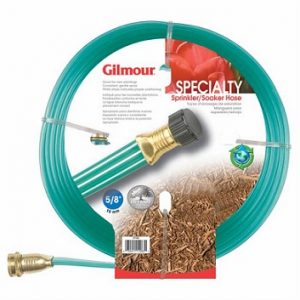
Flat hoses may be sold with a reel, but some hoses can be purchased separately. Flat garden hoses can be flattened out because they are flexible and can bend easily. They come with lower burst pressure rating and vinyl puncture and kink. These hoses may not work well when they are pulled around corners. You must unroll the whole hose before you turn on the water.
Flat garden hoses work best when space is limited. The hose can be used straight across a surface with no snags. These hoses are not recommended for regular use in the garden.
5. Coiled Garden Hose
Coiled hoses are made into tight spirals that can be pulled together for storage. They are usually shorter (15-foot to 25-foot) than a garden hose. However, they can be made with a 1/2-inch diameter or less.
These hoses are not able to stretch to their full length due to the coils. A 25-foot hose might only stretch 15 to 20 feet, so be aware of this when you buy one.
Storage can be tricky. Coiled hoses cannot be stored on a reel. They will quickly become tangled if they are placed in large containers or storage bins. Although there are stand-up and wall-mounted hangers available for storing coiled hoses, we have found that the coils can get caught on the hanger.
Hand watering is best done with oiled hoses. They can be used in small areas such as on a balcony or patio. The hose can then be stored away from the path.
6. Expandable Garden Hose
These hoses look similar to a scrunchie and when filled with water, they can expand up three times. They are lightweight at around 1 pound, and available in bright colors. They are approximately 1/2 inch in terms of diameter with enough water flow to match a non-expandable model. However, they do not have the same water flow as a regular hose.
While they expand as promised, expandable hoses can become uncooperative in terms of contracting properly over time, making it difficult to store or coil. After the hose has been expanded, it will shrink. This can sometimes happen very quickly.
Expandable hoses can burst if they are exposed to high water pressure, or if the hose is left in direct sunlight. This is because the inner tube is extremely flexible and thin.
Many people love the lightweight of expandable hoses. These hoses should be kept out of direct sunlight and treated with care (most often they have plastic couplings that are susceptible to cracking, but some hoses have brass couplings). They can also be used for hand watering rather than being connected to a soaker or sprinkler hose. You should be ready to change your hose often.
7. Drinking Water Safe Garden Hoses
If you are using the garden hose for providing water to your pets or for filling a swimming pool, you should ensure that the garden hose does not contain harmful chemicals.
Usually, the garden hoses come with plasticizers, which give garden hoses their flexibility. However, they also contain chemicals like lead and BPA that get into the water. These chemicals are not harmful to your plants but can be toxic to you.
So, in such cases, you can find garden hoses that are marked as drinking water safe and/or lead-free. These hoses are often sold for recreational purposes, such as in boats or RVs. They have non-toxic inner cores approved by the FDA that don’t release harmful chemicals.
If you left it under sun or heat, then make sure to let the water run through your hose until it cools down before you water your vegetables or other edibles. If not, the chemicals can leach from your warm hose into the water.
Summary
Though it is a simple piece of equipment, garden hoses should be purchased carefully. If not, you may end up with an investment that doesn’t work as per your requirements.
So, the first factor to consider while purchasing a garden hose is the suitable type. We have explored the options in depth here in this article.
As per our research, there are seven different garden hoses. There is no single best option among them. Every model has its perks and downsides. So, you can read the information to make the right choice.
Hope this article has shared some information that has helped you make a wise choice. If you still have any doubts, we recommend writing them below for your reference. We shall reply to them as early as possible.

